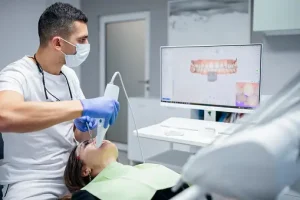
Technology has revolutionized modern dental care, enhancing diagnostics, treatments, and patient experiences. Here’s an overview of the pivotal role technology plays in dentistry:
1. Digital Imaging and X-rays
- Digital Radiography: Digital X-rays reduce radiation exposure and offer immediate results for quicker diagnoses.
- Cone Beam CT Scans: Provide detailed 3D images for precise treatment planning, especially for complex procedures like implants.
2. CAD/CAM (Computer-Aided Design/Computer-Aided Manufacturing)
- Same-Day Restorations: CAD/CAM technology enables the creation of crowns, veneers, and bridges on-site within a single appointment.
- Precision and Customization: Accurate digital impressions ensure precise fittings and personalized restorations.
3. Laser Dentistry
- Soft and Hard Tissue Procedures: Lasers are used for various treatments, including gum reshaping, cavity detection, and oral surgeries.
- Minimally Invasive: They offer precision, reduce bleeding, and often minimize the need for anesthesia.
4. Tele-dentistry
- Remote Consultations: Allows for consultations, follow-ups, and advice via video calls, improving access to care, especially in remote areas.
5. 3D Printing
- Prosthetics and Dental Models: Enables the creation of highly accurate dental prosthetics, models, and surgical guides.
6. Intraoral Cameras and Digital Scanners
- Enhanced Visualizations: Intraoral cameras provide high-resolution images, aiding in diagnosis and patient education.
- Improved Comfort: Digital scanners replace cleaning teeth montebello, offering a more comfortable experience for patients.
7. Artificial Intelligence (AI)
- Diagnostic Support: AI assists in diagnostics by analyzing data, aiding in the detection of issues like cavities or gum disease.
- Treatment Planning: AI-driven software helps in treatment planning and predicting outcomes for better patient care.
8. Enhanced Patient Experience
- Virtual Reality (VR) Distraction: VR headsets help alleviate dental anxiety by providing immersive distractions during procedures.
- Patient Education Tools: Interactive tools and simulations aid in educating patients about procedures and oral hygiene.
9. Practice Management Software
- Efficient Workflow: Streamlines administrative tasks, appointment scheduling, and patient record-keeping for smoother operations.
- Improved Communication: Facilitates communication between dental teams, specialists, and patients for better coordination.
10. Hygiene and Sterilization Advances
- Ultrasonic Cleaning Devices: Efficiently remove plaque and tartar while being gentle on teeth and gums.
- Sterilization Technology: Advanced sterilization techniques ensure optimal infection control.
11. IoT (Internet of Things) Devices
- Smart Toothbrushes: Monitor brushing habits and provide real-time feedback for better oral care at home.
- Smart Dental Devices: Track dental health metrics, encouraging proactive dental care practices.
12. Environmental Impact
- Green Dentistry: Embracing eco-friendly practices like digital records, reducing paper waste, and minimizing radiation exposure.
Technology continues to evolve, contributing to more precise diagnoses, efficient treatments, and improved patient satisfaction in the field of dentistry.







